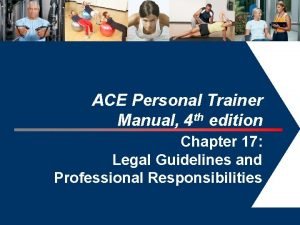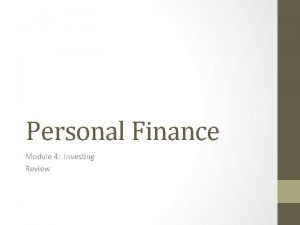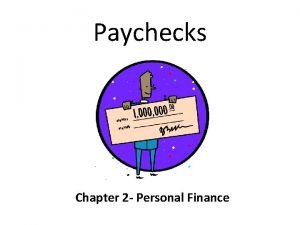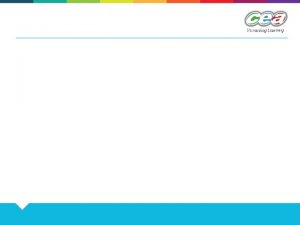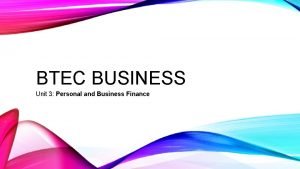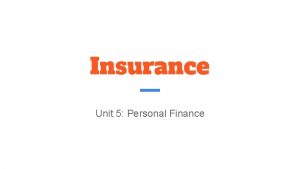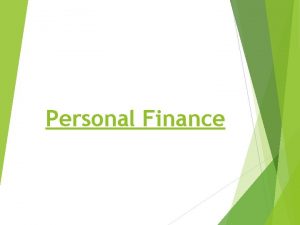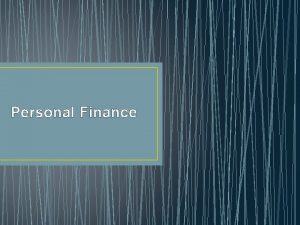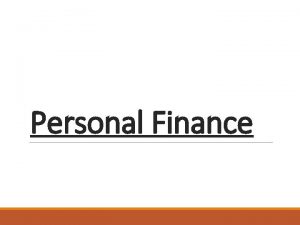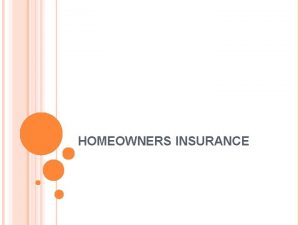How Insurance Works PERSONAL FINANCE Purpose The purpose









- Slides: 9

How Insurance Works PERSONAL FINANCE

Purpose The purpose of insurance is to transfer risk Individuals transfer risk to the insurance company For individuals, the risk may be small, but is totally unpredictable When aggregated over a large population though, the number if individuals who suffer a loss and the amount of the losses is often very consistent from year to year. For the insurance company, there is no risk if the total number of losses (and their size) can be accurately predicted in advance.

Example: Homeowner’s Insurance in Case of Fire Suppose your home is worth $100, 000 ◦ If it burns down, you lose $100, 000, which is a significant and unacceptable loss The law of large numbers allows us to accurately predict the number of house fires each year – but not to whom they will occur Suppose that one out of every 1, 000 homes burns down each year and that this figure is very consistent from year to year. If an insurance company insures 1 million homes, they can expect 1, 000 claims – give or take a few

Example: Homeowner’s Insurance in Case of Fire If the insurance company insures one million homes and charges $150 to insure each house, they will collect $150 million in premiums They expect to pay out very close to $100 million ($100, 000 times 1, 000 claims), leaving them $50 million for administrative expenses and profit For the individual, the choice is this: ◦ Buy the insurance and have a 100% chance of losing $150 or ◦ Don’t buy the insurance and have a 1% chance of losing $100, 000 Most individuals are risk-averse, so they choose to insure

Insurance The purchase of the insurance policy eliminates risk for the homeowner. He/she knows with certainty there will be a small loss (the premium), but does not have to prepare for the possibility of a large loss. This only works for insurance companies if they know the probability of the loss and the potential size of the loss for the group that they insure

Two Potential Problems for the Insurance Company Adverse Selection ◦ The risk that those who purchase the insurance are not representative of the population. ◦ Suppose that only pyromaniacs decide to buy fire insurance? Moral Hazard ◦ The risk that your behavior will change after you buy the insurance because you know the insurance company is on the hook for the loss, and not you. ◦ Suppose once you have the insurance, you decide not to spend the money on a smoke detector and you roast marshmallows around a campfire in your living room?

Battling Adverse Selection Insurance companies separate customers by risk class to combat adverse selection. In life and health insurance, they separate people into risk classes based on: Age Gender Smoking habits Other health issues Vocation and avocation issues

Battling Moral Hazard Insurance companies intentionally make it at least mildly inconvenient and somewhat costly if you suffer a loss The purpose is to combat moral hazard. They use the following: Coinsurance Deductibles Exclusions

Categories of Insurance What is insured ◦ Life and Health ◦ Property and Casualty Who is insured ◦ Personal lines ◦ Business lines Ownership of the insurance company ◦ Stock ◦ Mutual



